| Dr. Dave Clingerman, W6OAL, through his company Olde Antenna Lab, produces a commercial SETI LNBF assembly (integrated Low Noise preamp, Block downconverter and Feedhorn) for Project Argus use. Here on his workbench, the helical feed (left), LNA (right, smaller box) and downconverter (right, larger box) are awaiting installation into the PVC radome (seen at rear center).
W6OAL photo |
 20 December 2003 |
| Dish Array in Disarray: Although the Central Pennsylvania snow is light this winter, the winds are heavy, resulting in each of the eight dishes of the Very Small Array choosing its own target.
SETI League photo |
 13 December 2003 |
|
At this year's SETI League Annual Awards Banquet, Executive Director H. Paul Shuch presented Dr. Allen Katz with his Extra-Terrestrial QSL Card, for successful reception of the W2ETI Moonbounce Beacon.
SETI League photo |
 22 November 2003 |
|
8 November 2003 |
|
The Flag of Earth flies at SETI facilities around the world, including many of our members' Project Argus stations. Today, Flag of Earth creator James Cadle abandoned his 23-year-old copyright on the Flag, transferring it into the public domain. See this editorial for details.
SETI League photo |
 1 November 2003 |
|
This six-foot dish mounted on a joystick-controlled NASA/KSC Pelco mount is used for hydrogen line spectrometry with the Radio Astronomy Supplies SpectraCyber system. It is located on the front veranda of Jeff Lichtman's Fort Lauderdale FL villa, and illustrates how a small aperture antenna can be used in a confined space. Jeff is founder of the Society of Amateur Radio Astronomers.
Radio Astronomy Supplies photo |
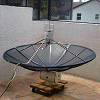 25 October 2003 |
|
 18 October 2003 |
|
 11 October 2003 |
|
 4 October 2003 |
|
During SETICon weekend in April, eight members participated in an optional Microwave Hardware Workshop. Here Dr. Malcolm Raff, WA2UNP, tests the bias on a low-noise preamplifier he has just finished constructing. Mal's amplifier yielded an impressive 0.6 dB noise figure and 17.47 dB of gain from 1 to 1.5 GHz.
SETI League photo |
 27 September 2003 |
|  20 September 2003 |
|  13 September 2003 |
|
Still in session this weekend, the Third European Radio Astronomy Congress convened yesterday in the shadow of Heppenheim Castle, at the Starkenburg Observatory in Heppenheim, Germany. For the second time, the triennial meeting is being co-sponsored by The SETI League. More photos from this year's Congress are available here.
SETI League photo |
 6 September 2003 |
|
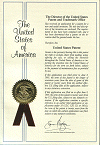 30 August 2003 |
|
The 2003 Giordano Bruno Memorial Award was presented last April to SETI pioneer Philip Morrison and his wife Phylis Morrison (in memoriam). Employing the very technology which the Father of SETI has long advocated for interstellar contact, H. Paul Shuch and Awards Committee chairman David Ocame made the presentation to Prof. Morrison via audio teleconference. Further details appear in this Press Release.
WA2UNP photo |
 23 August 2003 |
|
Since its inception, The SETI League has received loyal support from the Central States VHF Society, a leading group of amateur VHF-UHF experimenters in the US. The Society, a SETI League Affiliate Organization, awards annual Technical Development Grants to The SETI League to support such projects as our moonbounce beacon and Very Small Array radio telescope. Here CSVHFS treasurer Bruce Richardson, W9FZ, presents a check to executive director H. Paul Shuch, N6TX, at last month's Central States VHF Conference.
SETI League photo |
 16 August 2003 |
|
Two weeks ago, a number of SETI League members were among the fifty amateur radio astronomers and guests gathered at NRAO Green Bank WV for the annual SARA Conference. Here they are posed in front of the famous ten-meter parabolic dish built by Grote Reber, W9GFZ, in 1937. Click here for more SARA photos.
SETI League photo |
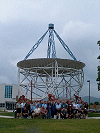 9 August 2003 |
|
At The SETI League's annual banquet in April, author Dr. David Darling spoke about the new partnership between astrobiology and SETI. The abstract of his presentation is linked from here.
SETI League photo |
 2 August 2003 |
|
Three months ago, Executive Director H. Paul Shuch tested his SETI Horn of Plenty antenna in the microwave laboratory at The College of New Jersey. The horn, a Project Argus antenna alternative, is described in a paper being presented this weekend at the Central States VHF Conference.
SETI League photo |
 26 July 2003 |
|
The three-meter dish at Argus station EM29je, with which Harry Kimball, N0TOU, achieved first light last month (see the 5 July 2003 Photo of the Week for his first Sun transit image). Harry says, "I modified the original feed support arm to hold an RAS cylindrical feed horn and choke with an RAS LNA. It looks funny because it's hiding under the bottom 1/3 of a 20 gallon plastic trash can that is held in place with 3 large hose clamps connected end to end." See more Project Argus stations.
N0TOU photo |
 19 July 2003 |
|
 12 July 2003 |
|
 5 July 2003 |
|
 28 June 2003 |
|
 21 June 2003 |
|
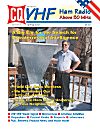 14 June 2003 |
|
 7 June 2003 |
|
31 May 2003 |
|
 24 May 2003 |
|

17 May 2003 |
|
 10 May 2003 |
|
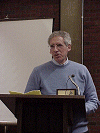 3 May 2003 |
|
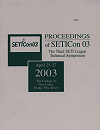 26 April 2003 |
|
19 April 2003 |
|
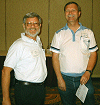 12 April 2003 |
|
 5 April 2003 |
|
 29 March 2003 |
|
 22 March 2003 |
|
 15 March 2003 |
|
 8 March 2003 |
|
 1 March 2003 |
|
 22 February 2003 |
|
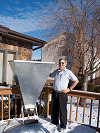 15 February 2003 |
|
 8 February 2003 |
|
 1 February 2003 |
|
 25 January 2003 |
|
 18 January 2003 |
|
 11 January 2003 |
|
 4 January 2003 |
Click here for lots more pictures.
email the Webmaster | entire website copyright © The SETI League, Inc. this page last updated 27 December 2003 |
Top of Page |
 SETI League Photo Gallery
SETI League Photo Gallery




